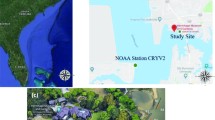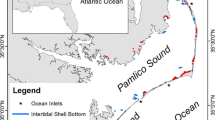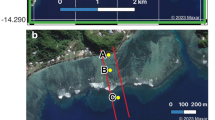Abstract
Constructed oyster reefs (CORs) provide shore protections and habitats for fish and shellfish communities via wave energy attenuation. However, the processes and mechanism of CORs on wave attenuation remain unclear, thus limiting the effective assessment of CORs for shoreline protection. This paper presents results of a field investigation on wave characteristics and wave spectral variations along a shoreline with CORs in an estuary with a large tidal range as well as large wind waves and swell energy. Six pressure transducers were deployed from January 31 to April 2, 2018, in Gandy’s Beach, New Jersey, in upper Delaware Bay. CORs were constructed at the study site in 2016 as living shoreline structures after Hurricane Sandy. The data collected from the study site exhibits the wave variations and spectral characteristics over the span of 2 months, including four winter storms (i.e., nor’easters). The spatial variations of wave heights measured on both sides of CORs show a strong dependence on the ratio between the freeboard of CORs and the offshore wave heights. Due to the large tidal range (> 2 m), the crests of CORs remain submerged over 85% of the time. The submerged CORs only provide partial attenuation of wave energy. The wave environment in the estuary is complex, especially during nor’easters. For instance, winds with rapid changing fetches could lead to bi-modal wind seas. Due to the complex wave spectra, the bulk wave heights such as the significant wave heights cannot be adopted to adequately reveal the capacity of CORs to attenuate wave energy. Spectral analysis is conducted to investigate the spatial and temporal variations of wave energy in targeted frequency bins. The spectral analysis results reveal the energy transfer from the primary waves to the high harmonics after waves propagate over the submerged CORs. Moreover, it is found that swell energy originated from the Atlantic Ocean can penetrate CORs without any dampening even when CORs are emergent. This study could help resource managers for in-depth evaluation of living shoreline effectiveness and improvement of living shoreline structures such as CORs.















Similar content being viewed by others
References
Aijaz, S., W.E. Rogers, and A.V. Babanin. 2016. Wave spectral response to sudden changes in wind direction in finite-depth waters. Ocean Modelling 103: 98 Waves and coastal, regional and global processes.
Bai, Y., and W.-L. Jin. 2016. Chapter 6 - wind loads for offshore structures. In Marine structural design, ed. Y. Bai and W.-L. Jin, 2nd ed., 95. Oxford: Butterworth-Heinemann.
Bradley, K., and C. Houser. 2009. Relative velocity of seagrass blades: implications for wave attenuation in low-energy environments. Journal of Geophysical Research - Earth Surface 114 (F1).
Chen, Q., P.A. Madsen, and D.R. Basco. 1999. Current effects on nonlinear interactions of shallow water waves. Journal of Waterway, Port, Coastal, and Ocean Engineering 125 (4): 176.
Conrad, K. 2015. Final environmental assessment for the Gandy’s Beach/Money Island Living shoreline project. Pleasantville: United States Fish and Wildlife Service New Jersey Field Office.
Dean, R.G., and R.A. Dalrymple. 1991. Water wave mechanics for engineers and scientists. Singapore: World Scientific.
Everett, T., Q. Chen, A. Karimpour, and R. Twilley. 2019. Quantification of swell energy and its impact on wetlands in a deltaic estuary. Estuaries and Coasts 42 (1): 68.
Freilich, M.H., R.T. Guza, and G.B. Whitham. 1984. Nonlinear effects on shoaling surface gravity waves. Philosophical Transactions of the Royal Society of London. Series A, Mathematical and Physical Sciences 311 (1515): 1.
Hu, K., and Q. Chen. 2011. Directional spectra of hurricane-generated waves in the Gulf of Mexico. Geophysical Research Letters 38 (19): L19608.
Hwang, P.A., F.J. Ocampo-Torres, and H. Garcia-Nava. 2012. Wind sea and swell separation of 1d wave spectrum by a spectrum integration method. Journal of Atmospheric and Oceanic Technology 29 (1): 116.
Jadhav, R., Q. Chen, and J.M. Smith. 2013. Spectral distribution of wave energy dissipation by salt marsh vegetation. Coastal Engineering 77: 99–107.
Jones, N.L., and S.G. Monismith. 2007. Measuring short-period wind waves in a tidally forced environment with a subsurface pressure gauge. Limnology and Oceanography: Methods 5. https://doi.org/10.4319/lom.2007.5.317.
Kamphuis, J.W. 2010. Introduction to coastal engineering and management. 2nd ed. Singapore: World Scientific.
Kaplan, D.A., M. Olabarrieta, P. Frederick, and A. Valle-Levinson. 2016. Freshwater detention by oyster reefs: quantifying a keystone ecosystem service. PLoS One 11 (12): e0167694.
Karimpour, A., and Q. Chen. 2017. Wind wave analysis in depth limited water using oceanlyz, a matlab toolbox. Computers and Geosciences 106: 181.
Karimpour, A., Q. Chen, and R.R. Twilley. 2017. Wind wave behavior in fetch and depth limited estuaries. Scientific Reports 7 (40654).
Kukulka, T., R.L. Jenkins III, J.T. Kirby, F. Shi, and R.W. Scarborough. 2017. Surface wave dynamics in Delaware Bay and its adjacent coastal shelf. Journal of Geophysical Research, Oceans 122 (11): 8683.
La Peyre, M.K., A.T. Humphries, S.M. Casas, and J.F. La Peyre. 2014. Temporal variation in development of ecosystem services from oyster reef restoration. Ecological Engineering 63: 34–44.
Leonardi, N., N.K. Ganju, and S. Fagherazzi. 2016. A linear relationship between wave power and erosion determines salt-marsh resilience to violent storms and hurricanes. Proceedings of the National Academy of Sciences 113 (1): 64–68.
Lowe, R.J., J.L. Falter, J.R. Koseff, S.G. Monismith, and M.J. Atkinson. 2007. Spectral wave flow attenuation within submerged canopies: implications for wave energy dissipation. Journal of Geophysical Research 112: C05018.
Munk, W.H., G.R. Miller, F.E. Snodgrass, N.F. Barber, and G.E.R. Deacon. 1963. Directional recording of swell from distant storms. Philosophical Transactions of the Royal Society of London. Series A, Mathematical and Physical Sciences 255 (1062): 505.
Oke, T.R. 1987. Boundary layer climates. 2nd ed. London: Routledge.
Seabrook, S., and K. Hall. 1998. Wave transmission at submerged rubblemound breakwaters. Coastal Engineering Proceedings 1 (26).
Seers, B. 2018. fetchR: calculate wind fetch. R package version 2.1-1. https://cran.r-project.org/package=fetchR.
Shi, F., J.T. Kirby, J.C. Harris, J.D. Geiman, and S.T. Grilli. 2012. A high-order adaptive time-stepping TVD solver for boussinesq modeling of breaking waves and coastal inundation. Ocean Modelling 43-44: 36.
Thornton, E.B., and R.T. Guza. 1983. Transformation of wave height distribution. Journal of Geophysical Research, Oceans 88 (C10): 5925.
US Fish and Wildlife Service. 2016. Hurricane Sandy recovery: Gandy’s Beach shoreline protection. https://www.fws.gov/hurricane/sandy/projects/GandysBeach.html. Accessed 29 Aug 2019.
van der Meer, J.W., R. Briganti, B. Zanuttigh, and B. Wang. 2005. Wave transmission and reflection at low-crested structures: design formulae, oblique wave attack and spectral change. Coastal Engineering 52 (10): 915 Low Crested Structures and the Environment.
Wiberg, P.L., S.R. Taube, A.E. Ferguson, M.R. Kremer, and M.A. Reidenbach. 2019. Wave attenuation by oyster reefs in shallow coastal bays. Estuaries and Coasts 42: 331.
Yang, Y., and J.L. Irish. 2018. Evolution of wave spectra in mound-channel wetland systems. Estuarine, Coastal and Shelf Science 207: 444.
Zhu, L., and Q. Chen. 2017. Effects of triad interactions on wave attenuation by vegetation. Journal of Engineering Mechanics 143 (9): 04017100.
Acknowledgments
We would like to thank Chris Witzigman (USGS), Moses Katkowski, Adrianna Zito-Livingston (The Nature Conservancy), Eris Schrading, and Danielle Mcculloch (US Fish and Wildlife Service) for assistance in field measurements. Thanks to Tristen Tagliaferri, Scott Warren, and two anonymous reviewers for their constructive reviews of an earlier version. Any use of trade, firm, or product names is for descriptive purposes only and does not imply endorsement by the US Government. Data associated with this paper have been deposited in USGS ScienceBase at: https://doi.org/10.5066/P9YEUNTM.
Funding
Funding for the study has been provided by the National Fish and Wildlife Foundation (NFWF, Project #55032).
Author information
Authors and Affiliations
Corresponding author
Additional information
Communicated by R. Scott Warren
Rights and permissions
About this article
Cite this article
Zhu, L., Chen, Q., Wang, H. et al. Field Observations of Wind Waves in Upper Delaware Bay with Living Shorelines. Estuaries and Coasts 43, 739–755 (2020). https://doi.org/10.1007/s12237-019-00670-7
Received:
Revised:
Accepted:
Published:
Issue Date:
DOI: https://doi.org/10.1007/s12237-019-00670-7




